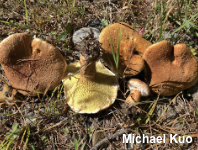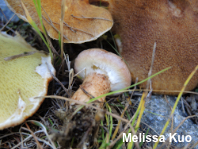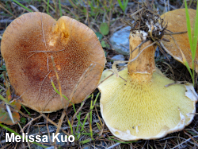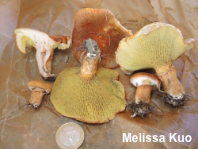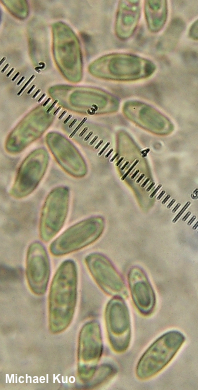| Major Groups > Boletes > Suillus > Suillus cavipes |

|
[ Basidiomycota > Boletales > Suillaceae > Suillus . . . ] Suillus cavipes by Michael Kuo, 6 October 2022 This is a fascinating and gorgeous Eurasian Suillus species, found under European larch (Larix decidua) throughout the range of the host tree, in northern and montane areas of the continent. It is fairly unmistakable, featuring a dry, densely hairy, brown cap, a beautifully yellow pore surface, and a brown stem that is almost always hollow when mature (hence the epithet cav-ipes, "hollow-stem"). A yellow form of the species, Suillus cavipes aureus, also appears under European larch; it is otherwise identical. Although "Suillus cavipes" appears in many North American field guides, Nguyen and collaborators (2016) provide DNA support for the idea that the North American species, associated with tamarack and western larch, is a separate species, the best name for which is Suillus ampliporus. Boletinus cavipes is a synonym. Description: Ecology: Mycorrhizal with larch (species of Larix, especially Larix decidua); growing alone or gregariously; fall; originally described from (and neotypified from) Austria; distributed in northern and montane Eurasia, where the host trees occur. The illustrated and described collection is from Alpine Italy. Cap: 4–9 cm; convex at first, becoming broadly convex; dry; densely hairy to sub-scaly with whitish to brown hairs and fibrils; yellowish brown, reddish brown, or brown; featuring white partial veil remnants on the margin. Pore Surface: Yellow; not bruising; pores angular and radially arranged, about 1–2 mm across; tubes to 5 mm deep. Stem: 3–6 cm long; 1.5–3 cm thick; equal or slightly club-shaped; yellow and bald toward the apex; brown and velvety below; with a fragile white ring; hollow; basal mycelium white. Flesh: White; not staining on exposure. Odor and Taste: Not distinctive. Spore Print: Olive brown. Microscopic Features: Spores 7–10 x 3–3.5 µm; boletoid-fusiform; smooth; yellowish in KOH. Basidia 25–28 x 4–5 µm; clavate; 4-sterigmate. Cystidia 45–60 x 5–10; cylindric or subfusiform; thin-walled; smooth; hyaline to yellowish in KOH. Pileipellis a cutis of elements 5–20 µm wide, smooth, hyaline to brownish in KOH, septate; with aggregations of upright hyphae; terminal cells cylindric to fusiform. REFERENCES: (J. F. Klotzsch, 1835) A. H. Smith & H. D. Thiers, 1964. (Phillips, 1981; Breitenbach & Kränzlin, 1991; Buczacki et al., 2013; Nguyen et al., 2016; Gminder & Böhning, 2017; Kibby, 2017; Knudsen & Taylor, 2018; Noordeloos, 2018; Læssøe & Petersen, 2019.) Herb. Kuo 09221807. This site contains no information about the edibility or toxicity of mushrooms. |
© MushroomExpert.Com |
|
Cite this page as: Kuo, M. (2022, October). Suillus cavipes. Retrieved from the MushroomExpert.Com Web site: http://www.mushroomexpert.com/suillus_cavipes.html |
